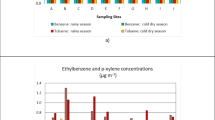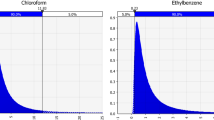Abstract
This study measures the effect of emissions from an airport on the air quality of surrounding neighborhoods. The ambient concentrations of benzene, toluene, ethylbenzene, and o-, m-, and p-xylene (BTEX) were measured using passive samplers at 15 households located close to the airport (indoor, outdoor, and personal), at the end of airport runways and an out-of-neighborhood location. Measurements occurred over a 48-h period during summer 2006 and winter 2006–2007. The average concentrations were 0.84, 3.21, 0.30, 0.99, and 0.34 μg/m3 at the airport runways and 0.84, 3.76, 0.39, 1.22, and 0.39 μg/m3 in the neighborhood for benzene, toluene, ethylbenzene, m-, p-, and o-xylene. The average neighborhood concentrations were not significantly different to those measured at the airport runways and were higher than the out-of-neighborhood location (0.48, 1.09, 0.15, 0.78, and 0.43 μg/m3, each BTEX). B/T ratios were used as a tracer for emission sources and the average B/T ratio at the airport and outdoors were 0.20 and 0.23 for the summer and 0.40 and 0.42 for the winter, suggesting that both areas are affected by the same emission source. Personal exposure was closely related to levels in the indoor environment where subjects spent most of their time. Indoor/outdoor (I/O) ratios for BTEX ranged from 1.13 to 2.60 and 1.41 to 3.02 for summer and winter. The seasonal differences in I/O ratios reflected residential ventilation patterns, resulting in increased indoor concentrations of volatile organic compounds during winter.
Similar content being viewed by others
References
Adgate, J. L., Church, T. R., Ryan, A. D., Ramachandran, G., Fredrickson, A. L., Stock, T. H., et al. (2004). Outdoor, indoor and personal exposure to VOCs in children. Environmental Health Perspective, 112(14), 1386–1392.
Atkinson, R. (1990). Gas-phase tropospheric chemistry of organic compounds: A review. Atmospheric Environment, 1(24A), 1–41.
Beyer, A., Wania, F., Gouin, T., Mackay, D., & Matthies, M. (2003). Temperature dependence of the characteristic travel distance. Enviromental Science & Technology, 37(4), 766–771.
Brasseur, G., Cox, A., Hauglustaine, D., Isaksen, I., Lelieveld, J., et al. (1998). European scientific assessment of the atmospheric effects of aircraft emissions. Atmospheric Environment, 32(13), 2329–2418.
Bravo, H., Sosa, R., Sánchez, P., Bueno, E., & González, L. (2002). Concentrations of benzene and toluene in the atmosphere of the southwestern area at the Mexico City Metropolitan Zone. Atmospheric Environment, 36(23), 3843–3849.
Brocco, D., Fratarcangeli, R., Lepore, L., Petricca, M., & Ventrone, I. (1997). Determination of aromatic hydrocarbons in urban air of Rome. Chemosphere, 31(4), 557–566.
Census (2000). Data for the State of New Jersey from http://quickfacts.census.gov/qfd/states/34/34003.html.
Dunlap, L., & Beckmann, D. (1988). Soluble hydrocarbons analysis from kerosene/diesel type hydrocarbons (pp. 37–45). Retrieved 6 January 2010 from https://info.ngwa.org/GWOL/pdf/890149560.PDF.
Edwards, R., Jurvelin, D., Koistinen, J., Saarela, K., & Jantunen, M. (2001). VOC source identification from personal and residential indoor, outdoor and workplace microenvironment samples in EXPOLIS-Helsinki, Finland. Atmospheric Environment, 35(28), 4829–4841.
Fellin, P., & Otrson, R. (1994). Assessment of the influence of climatic factors on concentration levels of volatile organic compounds (VOCs) in Canadian homes. Atmospheric Environment, 28(22), 3581–3586.
Gelencsér, A., Siszler, K., & Hlavay, J. (1997). Toluene-Benzene concentration ratio as a tool for characterizing the distance from vehicular emission sources. Environmental Science & Technology, 31(10), 2869–2872.
Georgopoulos, P. G., Wang, S. W., Efstathiou, C., Tong, S., & Lioy, P. J. (2003). Investigation of the impact of airport operations on local air quality, Teterboro Airport (Bergen County, NJ) operations on local air quality modeling analysis for 1999. Presentation by Environmental and Occupational Health Sciences Institute (EOHSI), Exposure Measurement and Assessment Division, July 23.
Gonzalez-Flesca, N., Bates, M. S., Dellmas, V., & Cocheo, V. (2000). Benzene exposure assessment at indoor, outdoor and personal levels. The French contribution to the Life Macbeth Programme. Environmental Monitoring and Assessment, 65(1–2), 59–67.
Guicherit, R. (1997). Traffic as a source of volatile hydrocarbons in ambient air. The Science of the Total Environment, 205(2–3), 201–213.
Henry, R., Lewis, C. W., & Collins, J. F. (1994). Vehicle-related hydrocarbon source compositions from ambient data: The GRACE/SAFER method. Environmental Science & Technology, 28(5), 823–832.
Ho, K. F., Lee, S. C., Guo, H., & Tsai, W. Y. (2004). Seasonal and diurnal variations of volatile organic compounds (VOCs) in the atmosphere of Hong Kong. Science of the Total Environment, 322(1–3), 155–166.
Holzman, D. (1997). Plane pollution. Environmental Health Perspective, 105(12), 1300–1305.
Ilgen, E., Karfich, N., Levsen, K., Angerer, J., Schneider, P., Heinrich, J., et al. (2001). Aromatic hydrocarbons in the atmospheric environment: Part I. Indoor versus outdoor sources, the influence of traffic. Atmospheric Environment, 35(7), 1235–1252.
Illinois Environmental Protection Agency (2002). Chicago O’Hare Airport. Air toxic monitoring program, June–December 2000. Retrieved from http://www.epa.state.il.us/air/ohare.
Kesgin, U. (2006). Aircraft emissions at Turkish airports. Energy, 31(2–3), 372–384.
Khoder, M. I. (2007). Ambient levels of volatile organic compounds in the atmosphere of Greater Cairo. Atmospheric Environment, 41(3), 554–566.
Kinney, P. L., Chillrud, S. N., Ranmstrom, S., Ross, J., & Spengler, J. D. (2002). Exposures to multiple air toxics in New York City. Environmental Health Perspectives, 110(S4), 539–546.
Kourtidis, K. A., Ziomas, I., Zerefos, C., Kosmidis, E., Symeonidis, P., Christophilopoulos, E., et al. (2002). Benzene, toluene, ozone, NO2, and SO2 measurements in an urban street canyon in Thessaloniki, Greece. Atmospheric Environment, 36(34), 5355–5364.
Lee, S. C., Chiu, M. Y., Ho, K. F., Zou, S. C., & Wang, X. (2002). Volatile organic compounds (VOCs) in urban atmosphere of Hong Kong. Chemosphere, 48(3), 375–382.
Na, K., & Kim, Y. P. (2001). Seasonal characteristics of ambient volatile organic compounds in Seoul, Korea. Atmospheric Environment, 35(15), 2603–2614.
Na, K., Kim, Y. P., Moon, I., & Moon, K. (2004). Chemical composition of major VOC emission sources in the Seoul atmosphere. Chemosphere, 55(4), 585–594.
Na, K., Moon, K., & Kim, Y. P. (2005). Source contribution to aromatic VOC concentration and ozone formation potential in the atmosphere of Seoul. Atmospheric Environment, 39(30), 5517–5524.
National Oceanic and Atmospheric Administration (NOAA) (2008). Air Resources Laboratory archive (http://www.arl.noaa.gov/READYamet.php).
New Jersey Department of Environmental Protection (2005). NJDEP air quality report. Retrieved from http://www.njaqinow.net/Default.htm.
Peace, H., & Maughan, J. (2006). Identifying the contribution of different airport related sources to local urban air quality. Environmental Modelling & Software, 21(4), 532–538.
Perkey, H., & Arslandbaş, D. (2008). The relationship between indoor, outdoor and personal VOC concentrations in homes, offices and schools in the metropolitan region of Kocaeli, Turkey. Water Air Soil Pollution, 191(1–4), 113–129.
Pison, I., & Menut, L. (2004). Quantification of the impact of aircraft traffic emissions on tropospheric ozone over Paris area. Atmospheric Environment, 38(7), 971–983.
Pratt, G. C., Bock, D., Stock, T. H., Morandi, M., Adagate, J. L., Ramachandran, G., et al. (2005). A field comparison of volatile organic compound measurements using passive organic vapor monitors and stainless steel canisters. Environmental Science & Technology, 39(9), 3261–3268.
Schneider, P., Lorinci, G., Gebefugi, I. L., Heinrich, J., Kettrup, A., & Wichmann, H.-E. (1999). Vertical and horizontal variability of volatile organic compounds in homes in Eastern Germany. Journal of Exposure Analysis and Environmental Epidemiology, 9(4), 282–292.
Schürmann, G., & Schäfer, K. (2006). Airport air quality and emission studies by remote sensing and inverse dispersion modeling. Remote sensing of clouds and the atmosphere XI. Proceedings of the SPIE, 6362, 63621E.
Schürmann, G., Schäfer, K., Jahn, C., Hoffmann, H., Bauerfeind, M., Fleuti, E., et al. (2007). The impact of NO x , CO and VOC emissions on the air quality of Zurich airport. Atmospheric Environment, 41(1), 103–118.
Sexton, K., Adgate, J. L., Ramchandran, G., Pratt, G., Mongin, S. J., Stock, T. H., et al. (2004). Comparison of personal, indoor, and outdoor exposures to hazardous air pollutants in three urban communities. Environmental Science & Technology, 38(2), 423–430.
Smith, L. A., Stock, T. H., Chung, K. C., Mukerjee, S., Liao, X. L., Stallings, C., et al. (2007). Spatial analysis of volatile organic compounds from a community-based air toxics monitoring network in Deer Park, Texas, U.S.A. Environmental Monitoring and Assessment, 128(1–3), 369–379.
Tesseraux, I. (2004). Risk factors of jet fuel combustion products. Toxicology Letters, 149(1–3), 295–300.
Unal, A., Hu, Y., Chang, M. E., Odman, M. T., & Russell, A. G. (2005). Airport related emissions and impacts on air quality: Application to the Atlanta International Airport. Atmospheric Environment, 39(32), 5787–5798.
U.S. Department of Transportation Federal Aviation Administration (2010). FAA Airport master record for TEB. Retrieved 6 January 2100 from http://www.gcr1.com/5010web/REPORTS/TEB.pdf.
World Health Organization (WHO) (1999). Air quality guidelines for Europe. WHO regional publication, European series. World Health Organization: Regional Office for Europe, Copenhagen.
Yu, K. N., Cheung, Y. P., Cheung, T., & Henry, R. (2004). Identifying the impact of large urban airports on local air quality by nonparametric regression. Atmospheric Environment, 38(27), 4501–4507.
Author information
Authors and Affiliations
Corresponding author
Rights and permissions
About this article
Cite this article
Jung, KH., Artigas, F. & Shin, J.Y. Personal, indoor, and outdoor exposure to VOCs in the immediate vicinity of a local airport. Environ Monit Assess 173, 555–567 (2011). https://doi.org/10.1007/s10661-010-1404-9
Received:
Accepted:
Published:
Issue Date:
DOI: https://doi.org/10.1007/s10661-010-1404-9




